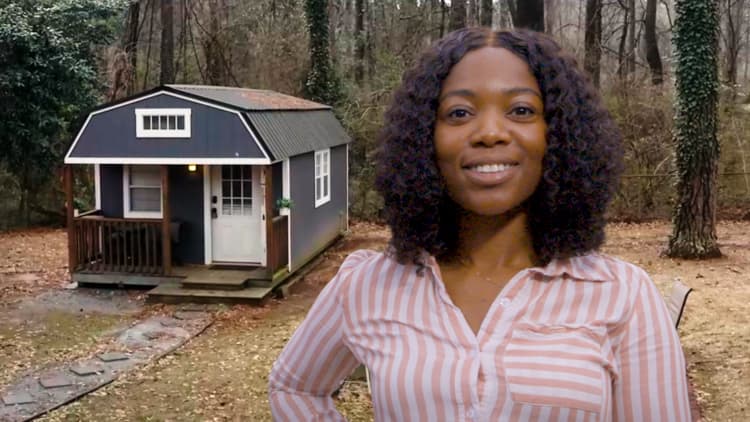This 28-year-old pays $62 a month to live in a dumpster he built for $5,000—take a look inside
Last October, I returned to London after working abroad for nearly a year in Central America and Southeast Asia.
Finding an apartment on a budget wasn’t easy. The average cost of a one-bedroom in Southwark, a borough in South London, is around $1,850 a month. That’s more than 75% of my income as an architectural designer.
At 28, my goal is to save up to buy a house of my own one day. But I didn’t want to move to the outskirts of the city, so I started looking into the possibility of living in a skip — or, as it’s called in the U.S., a dumpster.
Harrison’s tiny home sits on an empty lot in South London. The land was granted to him by an arts charity called Antepavilion.
Photo: Gergana Popova for CNBC Make It
How I turned a waste container into a tiny home
I run a small architecture company called CAUKIN Studio. We’ve done work with SKIP Gallery, which commissions emerging artists to create artwork in the confines of a dumpster.
After hearing about my project, an arts charity called Antepavilion granted me an empty, grassy lot in Southwark to put my house on. I currently rent the dumpster base from a waste management company for only $62 a month (although I have not been charged for it yet).
The building process, which began in December 2022, took three weeks. I had worked on similar projects in the past as an architect, so I had all the tools and knowledge I needed. On most days, my friends would come by and help.
The tiny home can be transported like a dumpster, so moving it from the construction site to the grassy lot was easy.
Photo: Gergana Popova for CNBC Make It
It cost me roughly $5,000 to build the home:
- Building supplies (including timber, insulation and fixings): $4,620
- Interior furnishings (including storage and foam mattress): $380
I used my savings to fund the expenses, and paid movers $635 to transport the dumpster from the manufacturer to the construction site, then to the lot where it stands today.
My electricity bill is so small that it is included in my land sponsorship, and my water supply consists of a hose pipe that runs from a neighbor’s property.
Harrison says it’s hard to wash up in his tiny home. He gets his water from a hose outside, and stores it in a glass jar.
Photo: Gergana Popova for CNBC Make It
For Wi-Fi, I use a dongle connected to mobile data to watch Netflix and take Zoom calls on my laptop. This costs $20 a month.
A look inside my tiny home
The base of the dumpster is only 25 square feet, so I had to make the most out of the volume to make the space livable.
The home’s entrance is up a small ladder and through a hatch door.
Photo: Gergana Popova for CNBC Make It
I have four built-in wooden boxes to put my clothes in. I’ve always lived a minimal lifestyle and traveled a lot for work, so the limited storage space works for me. I didn’t have to give away any items.
Up above is my raised, mezzanine-style bed.
An arched roof gives Harrison plenty of room in his mezzanine-style double bed.
Photo: Gergana Popova for CNBC Make It
On the other end is the kitchen. I have an eight-can portable mini fridge, a small sink and an induction cooktop.
Since kitchen space is limited, Harrison mostly cooks one-pot meals and often eats out with friends.
Photo: Gergana Popova for CNBC Make It
Windows on both sides of the home provide plenty of natural light and ventilation, making the space feel less claustrophobic.
The toilet is outside, so I need to leave my house every time I use it. There’s no shower either, so I’ll be using the one at work and at the gym for the foreseeable future. I do my laundry at a laundromat.
Harrison’s toilet is outside of the tiny home.
Photo: Gergana Popova for CNBC Make It
Getting used to the skip life
I’ve been living here for a few months now, and managing its inconveniences has slowly gotten easier.
But this is a great location in London. It’s a 15-minute bike ride to work, and I love spending my free time exploring the area or meeting up with friends.
My biggest challenging has been adjusting to all the attention. Many people stop by because they’ve seen me on the news.
The tiny home allows Harrison to live alone in a city where that’s a luxury, and has amplified the conversation about rent prices in London.
Photo: Gergana Popova for CNBC Make It
With its ups and downs, I’ve turned my living situation into an art piece. It shines light on the absurdity of London’s housing crisis in a way that makes people smile and think.
This has been a unique experience, and I’m grateful that it was sponsored. But I don’t recommend replicating it. I hope that I can move out soon, but I certainly won’t be swapping it for no savings and a small, damp room. It’s weirdly comfortable.
Harrison Marshall is the co-founder of CAUKIN Studio, a design studio that specializes in community and impact-based projects. He holds a master’s degree in architecture and has worked on more than 50 projects worldwide. Harrison combines his background with his passion for social impact to create experiences that spark joy and thought. Follow him on Instagram @caukinstudio and @theskiphouse.
Don’t miss:

For all the latest World News Click Here
For the latest news and updates, follow us on Google News.

